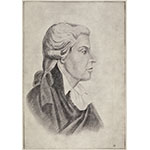Born in Pomarolo, near Trento (Trent), Fontana studied at the University of Padua. The University of Pisa appointed him a lecturer in logic in 1765, then lecturer in physics in 1766. In 1765, he was called to Florence by Grand Duke Peter Leopold of Tuscany (1747-1792), who named him court physicist and director of the Physics Cabinet of the Palazzo Pitti. There, his task was to organize the natural-history and scientific-instrument collections of the Museo di Fisica e Storia Naturale. In 1775-1776, he traveled to France and England with Giovanni Fabbroni (1752-1822), acquiring documents and books for the Museum and conducting research in pneumatic and mineralogical chemistry. The Museum, of which Fontana became the director, soon became a leading scientific institution. His thorough studies in biology, animal physiology, and chemistry often yielded original results. He collaborated with the Museum model-makers in the preparation of the famous anatomical waxes of La Specola. His most important works are: Dei moti dell'iride [Of the motions of the iris] (Lucca, 1765); Nuove osservazione sopra i globetti rossi del sangue [New observations on the globules of the blood] (1766); De irritabilitatis legibus[...] [On the laws of irritability] (1767); Ricerche fisiche sopra il veleno della vipera [Physical researches on the viper's venom] (Lucca, 1767); Descrizione e uso di alcuni stromenti per misurare la salubrità dell'aria [Description and use of some instruments to measure the salubrity of the air] (Florence, 1775); Ricerche fisiche sopra l'aria fissa [Physical researches on fixed air] (Florence, 1775); Recherches physiques sur la nature de l'air nitreux et de l'air déphlogistiqué [Physical researches on the nature of nitrous air and dephlogisticated air] (Paris, 1776); Traité sur le vénin de la vipere, sur les poisons americains [...] [Treatise on the viper's venom, on American poisons] (Florence, 1781, 2 vols); Opuscoli scientifici [Scientific pamphlets] (Florence, 1783).








